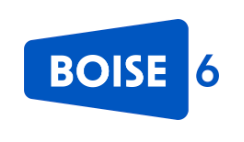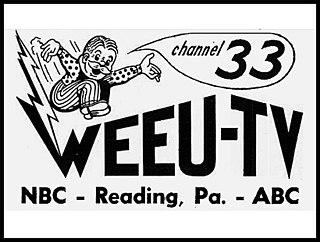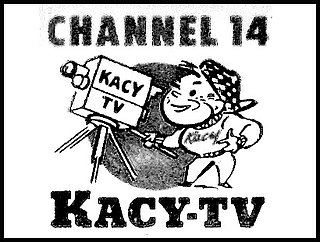Related Research Articles
KTVB is a television station in Boise, Idaho, United States, affiliated with NBC and owned by Tegna Inc. The station's studios are located on West Fairview Avenue in Boise, and its transmitter is located on Dear Point in unincorporated Boise County.

KBOI-TV is a television station in Boise, Idaho, United States, affiliated with CBS. It is owned by Sinclair Broadcast Group alongside low-power CW+ affiliate KYUU-LD. The two stations share studios on North 16th Street in downtown Boise; KBOI-TV's transmitter is located at the Bogus Basin ski area summit in unincorporated Boise County.

KIVI-TV is a television station licensed to Nampa, Idaho, United States, serving the Boise area as an affiliate of ABC. Owned by the E. W. Scripps Company, the station maintains studios on East Chisholm Drive in Nampa, while its transmitter is located at the Bogus Basin ski area summit in unincorporated Boise County.

KNIN-TV is a television station licensed to Caldwell, Idaho, United States, serving as the Fox affiliate for the Boise area. The station is owned by Marquee Broadcasting. KNIN-TV's transmitter is located at the Bogus Basin ski area summit in unincorporated Boise County, with its technical and news operations based out of the studios of Sinclair Broadcast Group–owned KBOI-TV on North 16th Street in Boise under a facilities and services agreement.
KTRV-TV is a television station licensed to Nampa, Idaho, United States, serving the Boise area as an affiliate of Ion Television. Owned by Inyo Broadcast Holdings, the station maintains offices on South Best Business Road in Kuna, and its transmitter is located at the Bogus Basin ski area summit in unincorporated Boise County.
KBOI is a commercial AM radio station in the western United States, located in Boise, Idaho. It is owned by Cumulus Media and airs a news/talk radio format. Studios and offices are on Bannock Street in Downtown Boise, while its six-tower transmitter site is located southwest of the city.

KIDO is a commercial radio station, owned and operated by Townsquare Media, which broadcasts a news/talk format. Licensed to Nampa, Idaho, it serves the Boise metropolitan area.

KFXD is a commercial radio station, owned by Townsquare Media, which airs a rhythmic contemporary format branded as "Power 105.5". The station is licensed to serve Boise, Idaho.
KCTY was a television station in Kansas City, Missouri, United States. It broadcast on ultra high frequency (UHF) channel 25 from June 6, 1953, to February 28, 1954, and was the second television station to begin broadcasting in the Kansas City area, after WDAF-TV. KCTY was an affiliate of the DuMont Television Network; originally owned by the Empire Coil Company, which had pioneered UHF telecasting, DuMont purchased the station outright at the end of 1953 and operated it for two months as a study in the problems of struggling UHF stations nationwide before concluding that there was no path to economic viability. The studio for KCTY was located in the Pickwick Hotel in downtown Kansas City, Missouri; the transmitter was located in a rural area that today is part of Overland Park, Kansas.

WROV-TV was a television station on ultra high frequency (UHF) channel 27 in Roanoke, Virginia, United States. It broadcast from March 2 to July 18, 1953, becoming the first UHF station in the United States to cease broadcasting. Its failure was the first of many in the early days of UHF television, which was hindered by signal issues in mountainous areas and the lack of UHF tuning on all television sets—a problem not resolved until the All-Channel Receiver Act took effect in 1964.
WKNY-TV was a television station in Kingston, New York, United States, which served the Hudson Valley from May 1954 to July 1956. Owned alongside radio station WKNY, it broadcast from studios and a transmitter site in Port Ewen, south of Kingston. Economic issues inherent with early ultra high frequency (UHF) stations led to its demise. It was approved to move to channel 21 but never did so.
KNUZ-TV was a television station broadcasting on ultra high frequency (UHF) channel 39 in Houston, Texas, United States, affiliated with the DuMont Television Network. It signed on the air on October 22, 1953, as Houston's third television station and first UHF outlet; it closed on June 25, 1954, after having lost money its entire existence and competing with two existing commercial very high frequency (VHF) outlets. KNUZ-TV's studios and transmitter were located at 4343 Cullen Boulevard in the Texas Television Center on the University of Houston campus.
KDZA-TV was a television station broadcasting on channel 3 in Pueblo, Colorado, which broadcast from March 16, 1953, to May 7, 1954. It was the first television station established in Pueblo. The station shut down due to financial difficulties, competition from a second station in Pueblo and two outlets in Colorado Springs, and network affiliation changes in Denver that affected its main programming source.

WEEU-TV was a television station that broadcast on UHF channel 33 from Reading, Pennsylvania, United States, between 1953 and 1955. It was owned by the Hawley Broadcasting Company alongside radio station WEEU. The station ceased broadcasting because of the economic difficulties associated with early UHF television stations.
WKAB-TV was a television station on channel 48 in Mobile, Alabama, United States. It was the first television station to broadcast in Mobile, operating from December 1952 to August 1954. As a UHF television station it was at a severe competitive disadvantage to the VHF station—WALA-TV—which started up in Mobile at the same time causing WKAB-TV to lose money and eventually fold.

KACY, UHF analog channel 14, was a television station serving St. Louis, Missouri, United States that was licensed to Festus. One of the earliest UHF television stations in the country, KACY boasted of being the "most powerful new television station in the Middle West" but was a near-immediate market failure, broadcasting from November 25, 1953, to April 2, 1954. The station unsuccessfully contended that a conspiracy by another St. Louis-area station had impeded it from carrying network programming.

KCIX-TV was a television station broadcasting on channel 6 in Nampa, Idaho, United States, from November 9, 1958, to January 4, 1960. It was the second attempt to establish a station on the allocation, after KFXD-TV, which had lasted two months in 1953.
WCOS-TV was a television station broadcasting on ultra high frequency (UHF) channel 25 in Columbia, South Carolina, United States. The first television station to broadcast in South Carolina, it was owned by Radio Columbia alongside the WCOS radio stations. It operated from 1953 until 1956, when it shut down and sold its assets to competitor WNOK-TV amid a difficult economic environment for UHF television stations.
KOPR-TV was a television station on channel 4 in Butte, Montana, United States, which operated from 1953 to 1954. It was owned by the Copper Broadcasting Company alongside KOPR and was the second outlet in Butte and the state, broadcasting from studios and a transmitter at the Hotel Finlen.
References
- ↑ "Television Applications Filed at FCC" (PDF). Broadcasting. July 7, 1952. p. 64. Retrieved March 8, 2021.
- ↑ "For the Record" (PDF). Broadcasting. March 23, 1953. p. 99. Retrieved March 8, 2021.
- 1 2 3 4 5 6 "KFXD-TV Suspends 2-Man Operation" (PDF). Broadcasting. August 24, 1953. pp. 71, 72. Retrieved March 8, 2021.
- ↑ "Idaho's First TV Signals Reach as Far as Weiser". Idaho Free Press. June 19, 1953. p. 1. Retrieved March 8, 2021.
- ↑ "SEVEN NEW TV STATIONS BEGIN, BRING COMMERCIAL TOTAL TO 194" (PDF). Broadcasting. July 6, 1953. p. 62. Retrieved March 8, 2021.
- 1 2 Huniwell, Shannon (August 2004). "Who Had Time To Notice KFXD-TV?" (PDF). Popular Communications. pp. 60, 61. Retrieved March 9, 2021.
- ↑ "Nampa TV Station Sets Next Week For Test Pattern". Idaho Free Press. June 12, 1953. p. 1. Retrieved March 8, 2021.
- ↑ "KFXD at Nampa to Start Television Tests Thursday". The Idaho Daily Statesman. June 13, 1953. p. 7. Retrieved July 30, 2021.
- 1 2 "KFXD Halts Telecasts". Idaho Free Press. August 13, 1953. p. 1. Retrieved March 8, 2021.
- 1 2 3 "Idaho Station Can't Make Grade, Quits" (PDF). Television Digest. August 22, 1953. p. 2. Retrieved March 8, 2021.
- 1 2 "Norfolk's WTAR-TV..." (PDF). Television Digest. April 3, 1954. p. 6. Retrieved March 8, 2021.
- ↑ "KFXD Asks Shift Okay". Idaho Free Press. Associated Press. p. 1. Retrieved March 8, 2021.
- ↑ "First GE directional..." (PDF). Television Digest. November 14, 1953. p. 6. Retrieved March 8, 2021.
- ↑ "Boise TV Station Obtains Channel Six From KXFD [sic]". Idaho Free Press. January 29, 1954. p. 1. Retrieved March 8, 2021.
- ↑ "Call Letters Assigned" (PDF). Broadcasting. April 19, 1954. p. 109. Retrieved March 8, 2021.
- ↑ "WGOV-TV Suspension Brings Video Dropout Total to 108" (PDF). Broadcasting. November 8, 1954. p. 54. Retrieved March 8, 2021.